
Biorock Electric Reefs Grow Back Severely Eroded Beaches in Months
Thomas J. F. Goreau 1,2 and Paulus Prong 2,3
1 Global Coral Reef Alliance, 37 Pleasant Street, Cambridge, MA 02139, USA
2 Biorock Indonesia, Bali 80361, Indonesia
3 Pulau Gangga Dive Resort, Sulawesi 95253, Indonesia
Abstract
Severely eroded beaches on low lying islands in Indonesia were grown back in a few months—believed to be a record—using an innovative method of shore protection, Biorock electric reef technology. Biorock shore protection reefs are growing limestone structures that get stronger with age and repair themselves, are cheaper than concrete or rock sea walls and breakwaters, and are much more effective at shore protection and beach growth. Biorock reefs are permeable, porous, growing, self-repairing structures of any size or shape, which dissipate wave energy by internal refraction, diffraction, and frictional dissipation. They do not cause reflection of waves like hard sea walls and breakwaters, which erodes the sand in front of, and then underneath, such structures, until they collapse. Biorock reefs stimulate settlement, growth, survival, and resistance to the environmental stress of all forms of marine life, restoring coral reefs, sea grasses, biological sand production, and fisheries habitat. Biorock reefs can grow back eroded beaches and islands faster than the rate of sea level rise, and are the most cost-effective method of shore protection and adaptation to global sea level rise for low lying islands and coasts.
Severely eroded beaches on low lying islands in Indonesia were grown back in a few months—believed to be a record—using an innovative method of shore protection, Biorock electric reef technology. Biorock shore protection reefs are growing limestone structures that get stronger with age and repair themselves, are cheaper than concrete or rock sea walls and breakwaters, and are much more effective at shore protection and beach growth. Biorock reefs are permeable, porous, growing, self-repairing structures of any size or shape, which dissipate wave energy by internal refraction, diffraction, and frictional dissipation. They do not cause reflection of waves like hard sea walls and breakwaters, which erodes the sand in front of, and then underneath, such structures, until they collapse. Biorock reefs stimulate settlement, growth, survival, and resistance to the environmental stress of all forms of marine life, restoring coral reefs, sea grasses, biological sand production, and fisheries habitat. Biorock reefs can grow back eroded beaches and islands faster than the rate of sea level rise, and are the most cost-effective method of shore protection and adaptation to global sea level rise for low lying islands and coasts.
(This article belongs to the Special Issue Coastal Sea Levels, Impacts and Adaptation)
1. Introduction
Accelerating global sea level rise is now causing almost all beaches worldwide to erode [1]. The current rate of sea level rise, now 3 mm/year [2], will accelerate greatly in the future as the melting of ice caps increases, masked by shorter term regional fluctuations driven by local weather [3]. IPCC projections of sea level rise are often thought by the public to represent the end point of sea level rise response to fossil fuel CO2, but in fact they are merely points along the first 5, 10, 20— or at most 100—years, of the initial rise of a curve that will continue to increase for thousands of years. The time horizons for IPCCC climate change projections were chosen for political purposes, not for scientific ones, and therefore miss the vast bulk of the real world long-term sea level and temperature responses to increased greenhouse gases [4].
Since the ocean holds nearly 93% of the heat in the Earth ocean-atmosphere-soil-vegetation-rock-ice system [5] and it takes around 1500 years for the ocean to mix and turn over [6], Earth’s surface will not fully warm up until after the deep ocean waters, now about 4 degrees above freezing, heat up. Global temperatures and sea levels lag thousands of years behind CO2 increases because of ocean mixing, so we have not yet really begun to feel the inevitable temperature and sea level responses. Because of these politically chosen time horizons, IPCC projections do NOT include more than 90% of the long-term climate response to changing CO2 [4,7-9]. By greatly underestimating the all too real long-term responses of temperature and sea level, they have lulled political decision makers into a false sense of complacency about the magnitude and duration of human-caused climate change or the urgency of reversing them before the really serious impacts hit future generations [4].
Improved estimates of long-term global climate impacts are made from actual paleoclimate records of changes in global CO2, temperature, and sea levels from the Antarctic ice cores, deep sea sediments, and fossil coral reefs over the last few million years [7,9]. The last time that global temperatures were 1-2 °C above today’s level, sea levels were about 8 m higher, crocodiles and hippopotamuses lived in swamps where London, England, now stands (Rhodes Fairbridge, 1987, personal communication) [10,11], and CO2 levels were around 270 ppm, around 40% lower than today [7,9]. Comparison of long-term global climate change records suggests that the steady state climate for the present (2017) CO2 concentration of 400 ppm, once the climate system has fully responded, are about 17 °C and 23 m above today’s levels [9]. We are committed to such changes even if there is no further CO2 increase starting right now because of the excess already in the atmosphere, unless that is reduced. No amount of emissions reduction can reduce excess atmospheric CO2, only increased natural carbon sinks with storage in soil and biomass carbon can draw down the dangerous excess in time to avert extreme long term changes [4,8,12], which would last for hundreds of thousands to millions of years. Perhaps the largest cost of adaptation to climate change will be the cost of protecting low lying islands and coasts from being flooded by global sea level rise.
Beach erosion is largely controlled by refraction of offshore waves by bottom topography [13]. The reflection of waves by steep cliffs prevents any accumulation of sand at their bases. In contrast, shallow sandy beach fore-shores are almost always protected from waves by reefs, Waves are refracted as water passes through porous and permeable reef structures, without being reflected.
Conventional methods of shore protection rely on “hard” solid structures like sea walls and breakwaters that are designed to reflect waves, like rock cliffs. This concentrates all the energy of the wave at the hard, reflecting surface, and the force on the structure itself is twice the momentum of the wave due to the reversal of the wave direction vector [14,15]. The inevitable result of this energy focusing is that first all the sand is washed away in front of the structure, and then is scoured away underneath it until the structure settles, cracks, falls apart, and needs to be rebuilt. These structures protect what is behind them until they fall down, but they cause erosion in front of them and guarantee loss of sediment. All such structures are consequently ephemeral and will fall down sooner or later, depending on how large and strong they are.
This is well known to coastal engineers but most feel there is no alternative to impermeable solid walls, even though so called “porous” or “permeable” breakwaters, made of small distributed modules shaped like coral reefs, with holes within structures and passages between them, seem to protect shores with much less material and with greatly reduced reflection. But we could find no experimental or theoretical modeling literature on porous permeable structures like natural coral reef structures found by searching on Google Scholar. Most search results for porous breakwaters were for solid rock walls with crevices between stones rather than reef-like structures with a much greater range of pore and spacing sizes, capable of interacting with waves over larger wavelength ranges.
Coral reefs provide the most perfect natural shore protection, dissipating around 97% of incident wave energy by frictional dissipation [16]. Healthy reefs produce sand as well as protect it, and rapidly build beaches behind them. They are sand factories, generating vast amounts of new sand, largely remains of calcareous green and red algae. Every grain of white limestone sand on a tropical beach is the skeletal remains of a living coral reef organism. Once corals die from high temperatures, pollution, or disease, the previously growing and self-repairing reef framework starts to deteriorate and crumble from boring organisms that excavate the rock [17]. Because of the mass mortality of corals around the world caused by global warming [18-23], tropical beaches that were growing until recently have begun rapid erosion, and islands are washing away because of global sea level rise.
Here we describe the results of a novel method of beach restoration—Biorock electric reef shore protection—which avoids the intrinsic physical flaws of hard reflective structures, and which grows beaches back at record rates at a lower cost, with less materials, and with much greater environmental benefits than seawalls. Biorock electric reefs are grown by low voltage electrolysis of sea water, which causes growth of limestone rock minerals dissolved in sea water over steel surfaces, which are completely protected from corrosion [24,25]. Biorock reef structures can be any size or shape, and are the only marine construction material that gets stronger with age and is self-repairing [26]. When grown slowly, less than 1-2 cm/year, this material is several times harder than Portland Cement concrete [25].
Biorock shore protection reefs are open mesh frameworks designed to permit water to flow through them, like coral reefs. The size and shape of the structures, and of the holes in them, determine their performance dissipating wave energy. The electricity needed for electrolysis is safe extremely low voltage (ELV) direct current provided by transformers, chargers, batteries, solar panels, wind mills, ocean current generators, or wave energy generators, depending on which source is most cost effective at the site [27].
Biorock reefs in Grand Turk survived the two worst hurricanes in the history of the Turks and Caicos Islands, which occurred three days apart and damaged or destroyed 80% of the buildings on the island [28]. Sand was observed to build up around the bases of Biorock reef structures. In contrast, concrete reef balls nearby caused such severe sand scour around and under them that they buried themselves into the sand, digging their own graves. Solid objects, by forcing bottom currents to accelerate as they diverge around them, cause erosion to a depth of about half the height of the structure, and about as wide as the structure height [29]. Biorock reefs, being permeable and porous to waves, had the opposite effect than reef balls, baffling waves, lowering their velocity, and causing sand deposition instead of erosion [30].
The first Biorock shore protection reef was built in front of a beach that had washed away at Ihuru Island, North Male Atoll, the Maldives, in 1997. Sand bags were being piled in front of trees and buildings that were falling into the sea, which the hotel thought they had no chance of saving. The Biorock reef was a linear structure parallel to the shore, 50 m long, about 5 m wide, and about 1.5 m high, built on eroded reef bedrock. The structure cemented itself solidly to the limestone bedrock with mineral growth. Waves were observed to slow down as they were refracted through the structure, dissipating energy by surface friction. Sand immediately began to accumulate on the shore line and under and around the reef, and the beach grew back naturally and rapidly in a few years, and stabilized with no further erosion, even though the 2004 Tsunami passed right over it [30]. Corals growing on the Biorock reef had 50 times (5000%) higher coral survival than the adjacent natural coral reef after the 1998 coral bleaching event [25]. For a decade after the bleaching event this resort had the only healthy reef full of corals and fishes in front of their beach in the Maldives. The hotel whose reef and beach were saved by the Biorock project turned the power off, with the result that the corals, no longer protected from bleaching by the Biorock process [31,32], suffered severe mortality in the 2016 bleaching event.
The second group of Biorock shore protection reefs were built at three eroding beach locations at Gili Trawangan, Lombok, Indonesia around 2010. These consisted of 4 to 6 separate reef modules designed to break waves up by slowing down separate portions of the wave front and driving the incoming wave front out of coherence, using less structural materials. The Biorock structures are shaped like an upside-down wave, which is optimal for dissipating wave energy, with no vertical surfaces to cause reflections, and so are called Biorock Anti-Wave structures (BAW). Although these structures were small, new beach growth was clearly visible at all sites within 8 months on Google Earth images [30]. One set of structures was of, and creation of a gap underneath it, so that it was on the way to falling down. One year later the gap underneath had completely filled in, and the sand had risen by about a meter to cover half the vertical wall height. The seawall on the neighboring property, built at the same time, but not protected by Bioorck, completely collapsed within a year [30]. The hotels whose beaches had been restored by the projects then turned the power off. Because the structures, no longer maintained, growing, or protected from rusting, are now collapsing, beach erosion has now resumed, with new sea walls being constantly built and falling down.
2. Materials and Methods
Pulau Gangga, North Sulawesi, Indonesia, has suffered progressive beach erosion. The index maps show its location on various scales (Figure 1a-d), and Google Earth images show the rapid erosion of the beach between 2013 and 2014 (Figure 2a,b). The site is outside the typhoon belt because it is close to the Equator, but it is affected by both the Australian and Indo-China Monsoons. From around December through May the winds and waves are usually from the southeast. A strong southward tidally-modulated current normally sweeps sand from north to south at the site.
The formerly wide sand beach had largely washed away by late 2015, leaving an erosion cliff about 1.36 m high along the shore, with trees falling into the sea, and beach pavilion buildings have had to be repeatedly torn down and moved inland. In front of the 200 m of severely eroded beach we built 48 Biorock Anti Wave reefs in a staggered design to dissipate wave energy before it hits the beach. The time of installation, January 2016, was just before the monsoon season when erosion takes place on this beach, and was done as fast as possible before waves made installation difficult.
48 Biorock Anti Wave reefs were deployed in the sea grass beds in front of the eroding beach in January 2016. They were arrayed in twelve groups of four, each group powered by a single power supply located 100 m away on land, connected by electrical cables dug into the sand (Figures 3 and 4a-d). They grow thickest at the bottom, and thinnest on top. The bottom 10-20 cm of the structures were always submerged at low tide, but above this they were exposed to the air for various periods, depending on the tidal cycle. Since structures grow only when and where submerged in salt water, the bottoms are always growing, while the top grows only when submerged, about half of the time. The gabion baskets were deployed in a grid pattern (visible from aerial images below) at low tide in shallow sand, seagrass, and coral rubble.
The resort had previously purchased gabion wire baskets for stones to make a breakwater, not knowing that these would quickly rust and fall apart. Because these were already available, they were incorporated into the core of the Biorock Anti Wave structures, because the Biorock electrolysis process prevents any rusting of the steel. The rocks are bound in place by growth of minerals over the mesh and by prolific growth of barnacles, oysters, and mussels, preventing rock shifting in heavy surge from breaking the gabion. There are both advantages and disadvantages to the use of rock gabions in Biorock shore protection structures, as they can cause scour by acting as a near solid wall, but they cause more rapid initial results slowing wave erosion than a more open structure that does not incorporate them. Gabions are not an essential part of the design, in fact not using them makes BAW units much faster and cheaper to construct and deploy. In this study gabions were used only for convenience as they had been previously bought and were already on site. Not to include rocks at all relies purely on the growth of a biological reef to provide long-term growing shore protection, instead of that provided by the rocks.
The core of each structure was a double gabion basket, 1 m × 1 m × 2 m with the long dimension parallel to the shore. These were placed on the shallow sea floor at predetermined sites, with the long axis parallel to the shore, and filled in with rounded river stones (largely in the 20-50 cm size range). At the start, the rocks had clean surfaces with nothing growing on them. The gabion baskets were overlain with standard welded steel mesh bars used in local construction, spacing 15 cm, dimensions about 2.1 m by 5.4 m. These sheets were curved into an arc to fit over the top of the gabion basket, with the long dimensions at right angles, so that the long axis of the arc was perpendicular to the shore, oriented into the waves coming over the shelf edge coral reef. They were welded across at the base with support rebars and vertical bars to strengthen them. Each unit was carried by four people at low tide, placed over a gabion basket and wired to it with hose clamps and binding wire. The growth of minerals over the steel cement it firmly to any hard rock bottom, and cement sediment around the bases on sand or mud, firmly attaching the structure to the bottom. The structures sit on the bottom under their own weight and that of the rocks they contain.
Beach profiles were measured using the U-tube water level measuring method [32]. They are estimated to be accurate vertically to about a millimeter, and horizontally to about a centimeter, by repeated measurements. The beach profile before the start of the experiment was estimated from photographs taken before and after from the same positions with common objects of known size in the images for scale. The accuracy of the pre-project beach profile estimate is thought to be about 10 cm vertically and one meter horizontally. Unfortunately, the apparatus for making rapid and accurate beach profiles was not built until September 2016, eight months after the start of the project. A second set of measurements was made in January 2017, a year after the start of the project, after a severe storm and at several more intervals since then. Initial beach profiles were estimated by measuring the height of the erosion cliff at the start of the project using the measured height of concrete foundations as a scale.
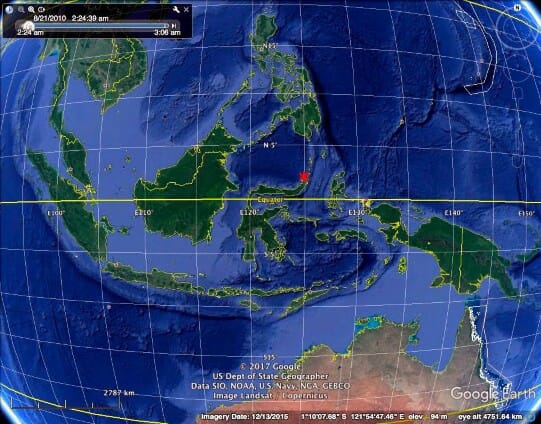
(a)
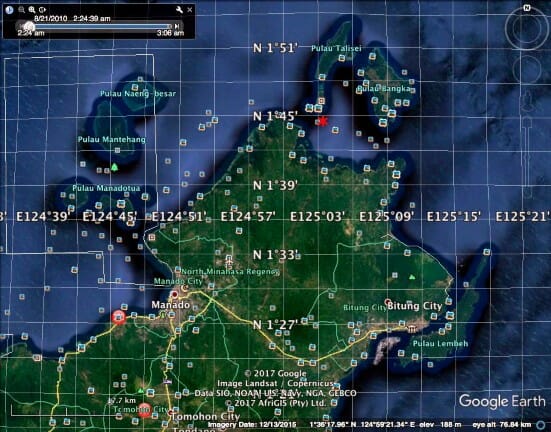
(b)
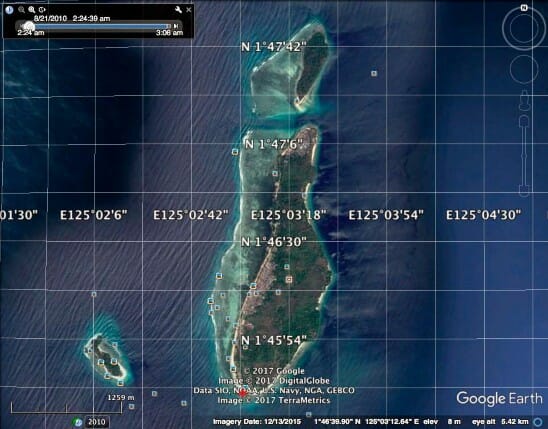
(c)
Figure 1. The site shown on Google Earth Images of the location of the project (red star) on decreasing scales: (a) Indonesia, (b) North Sulawesi, (c) Pulau Gangga
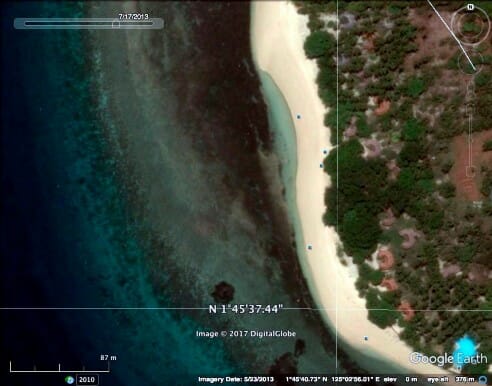
(a) 23 May 2013
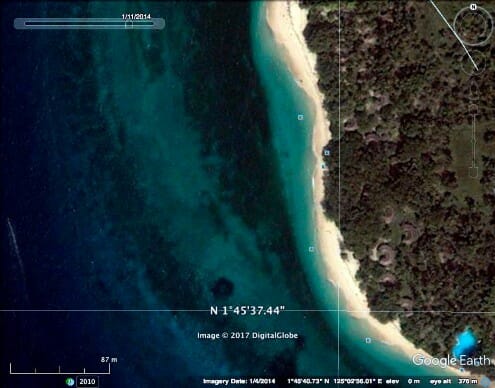
(b) 4 January 2014
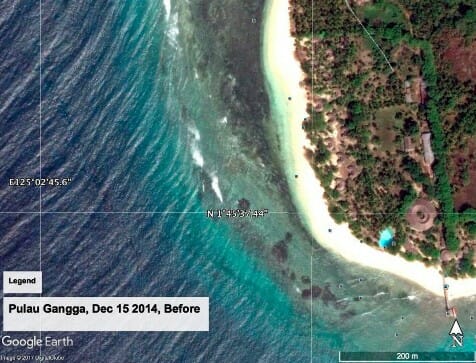
(c) 15 December 2014
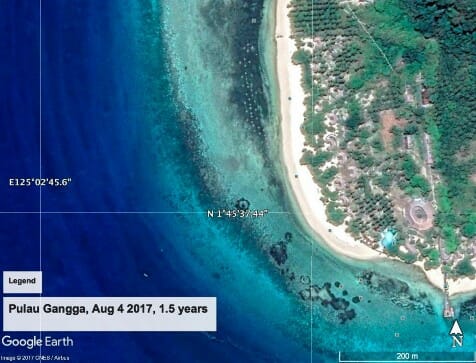
(d) 4 August 2017
Figure 2. Erosion of the beach prior to the project. Google Earth images from 2013 (a) and 2014 (b) showing short term changes in the beach before the project, the last available image taken near low tide a year before the project began in early 2016 (c), and the first image after the project, taken near high tide 1.5 years after (d). Notice the cores of the Biorock Anti Wave modules as white spots in the seagrass off the regenerated beach. Beach erosion beyond the project near the pier at the south was caused by storm waves from the southeast and longshore drift sand blockage by the solid rock pier. Waves from the northwest shown in (c) are typical during erosion of this westward facing beach. Note the row of pavilions (dark spots) on the edge of the beach erosion scarp and brown dying trees with roots exposed in (c) and how in (d) the roofs are now hidden by new leaf canopies due to prolific tree leaf regrowth after sand buildup around their roots.

Figure 3. Soon after start of the project, at low tide (wide angle image). The tops of the reef restoration structures are clearly visible. The eroded curve is the area where the beach grew back.
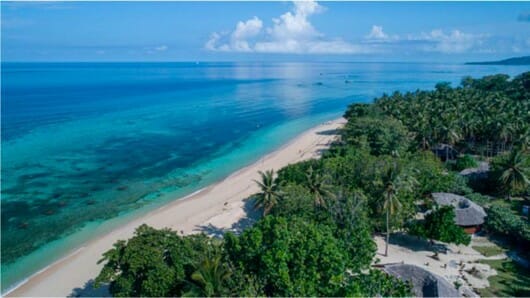
(a)
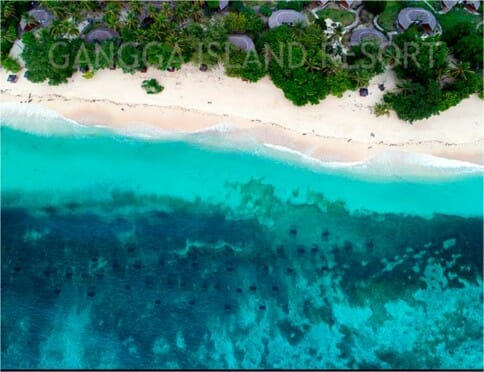
(b)
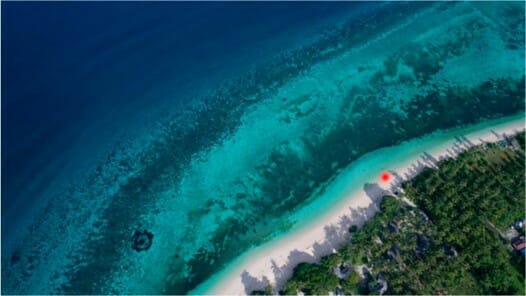
(c)
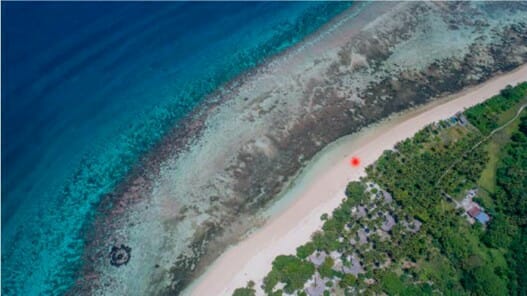
(d)
Figure 4. Aerial views, oblique at low tide (a) and vertical at high tide (b) on 12 March 2017, fourteen months after the installation, showing the Biorock Anti Wave structures (dark spots in sea grass beds). The northern edge of the project, on the same day at high (c) and low (d) tides. The Red spot in the last image two images is the northern limit of the project.
3. Results
The speed of beach regrowth astonished local residents. The formerly concave beach, ending in an eroding cliff, is now convex in its profile and growing. Large trees that had been dying after sand washed away, exposing their roots to sea water, have leafed out new canopies since the sand built up around their roots.
By the time of the first beach profile measurements the eroded beach had almost completely grown back and the erosion scarp, 1.36 m tall, was reduced to about 10 cm. About 80% of the beach grew back in less than 3 months and has continued to grow ever since, even during strong storm conditions that in the past caused severe erosion. Over the course of a year the beach has increased in height by more than a meter, and in width by more than 15 m, over a two hundred meter length, a conservative estimate of an increase of beach sand volume of 3000 cubic meters. Most of the gains occurred in the first two months, but have continued since (Figure 5a-g).
The beach growth in the first year was wider at the south than at the north. But there were interesting differences after a severe storm in early January, which caused some erosion of the southern end of the beach, while there was substantial growth of the central and northern sections. Since then the center and north have continued to grow, while the south has continued to erode slowly (Figure 6a-c).
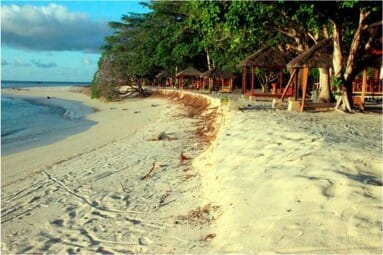
(a) November 2015
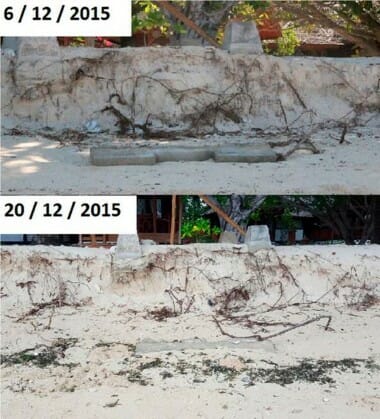
(b) December 2015
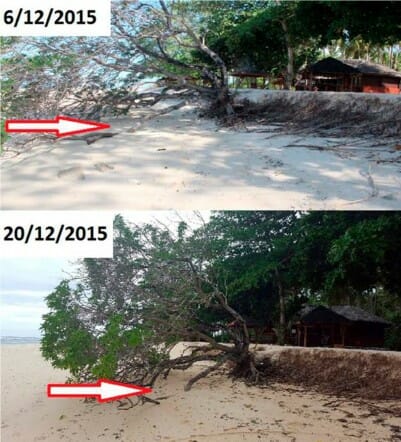
(c) December 2015
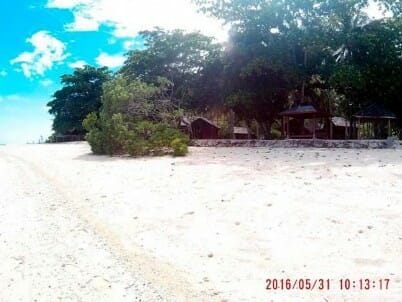
(d) May 2016
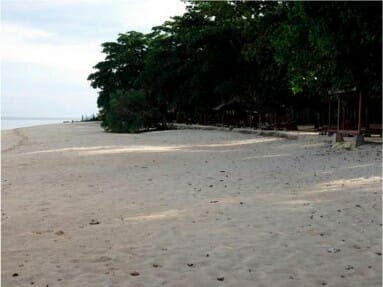
(e) August 016
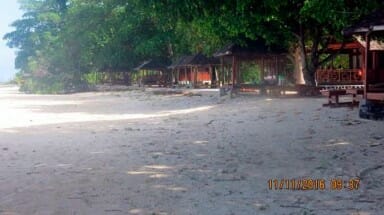
(f) November 2016
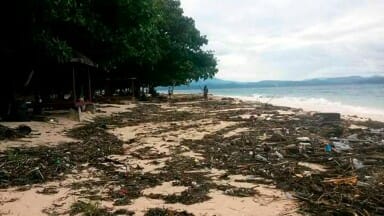
(g) January 2017
Figure 5. Before & after photos of beach taken at various times: (a) November 2015, beach looking north two months before start of project, tree falling into the sea and roots exposed at beach erosion scarp, (b) December 2015, one month before project, 1.36 m high erosion scarp and foundations of beach pavilions about to collapse near center of beach, (c) December 2015, one month before project, large old tree collapsing into the sea, leaves dying, roots exposed, (d) May 2016, 4 months after project installation, lower branches of fallen tree buried in new beach sand growth, roots buried, new growth, (e) August 2016, seven months after, (f) November 2016, ten months after, (g) January 2017, Twelve months after, soon after a severe storm, looking south. Most of the beach grew after the storm, even though this was the sort of event that had caused heavy erosion in the past. The south end, shown here, was worst affected.
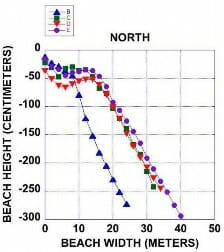
(a)
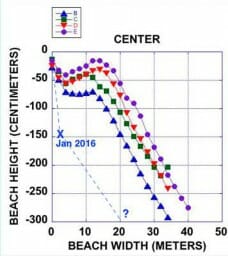
(b)
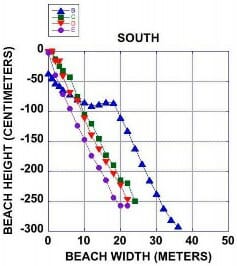
(c)
Figure 6. Beach profiles, measured at different times for the north (a), center (b), and south (c). The Zero reference datum for the central profile is the top of the concrete pillar foundation at the left of the December 2015 photograph. A 1.36 m vertical cliff stood at what is now the zero distance, based on measurements from photographs. Dates of measurements: X and dashed line estimate from January 2016; KEY to symbols: B upward triangle, 21 September 2016; C square, 11 January 2017; D downward triangle, 11 March 2017, E circle, 10 July 2017.
There has been prolific growth of hard and soft corals all over the bases of the structures and in intervening areas (Figure 7a-e), prolific growth of sea grasses all around them, dense settlement and growth of barnacles, mussels, and clams on the rocks in the core of the BAW structures, and a rapid increase in juvenile fish and echinoderm populations. In addition, there has been prolific growth of sand-producing calcareous green and red algae around and between the structures.
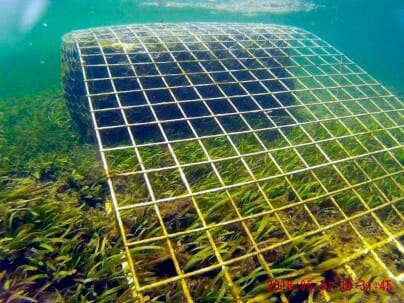
(a)
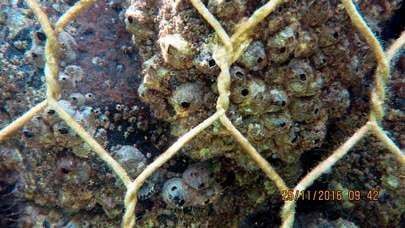
(b)
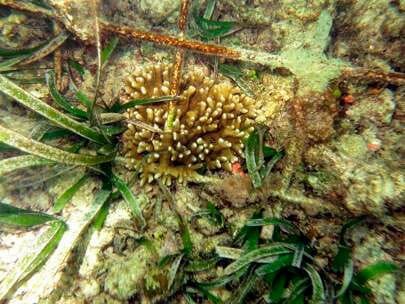
(c)
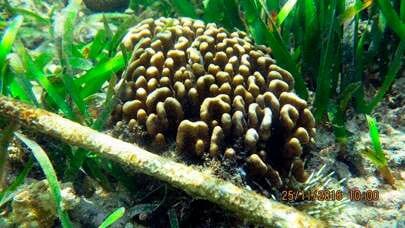
(d)
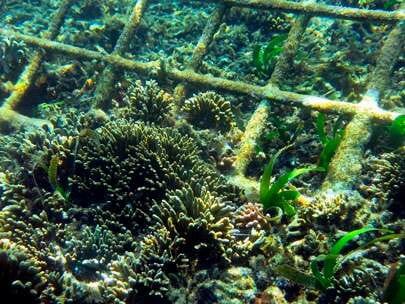
(e)
Figure 7. Underwater images: One end of a Biorock Anti Wave structures at high tide soon after installation (a), growth of barnacles over smooth river stones inside the gabions (b), examples of rapid growth of corals, sea grasses, and other organisms under, over, and around their bases (c–e).
Wave fronts are dissipated as they pass through the structures, breaking up the coherence of incoming wave fronts (Figure 8a-c). This dissipation behaves as refraction through permeable structures. But the wave interaction can include a reflective component once structures have grown to be solid with all pores filled in, or if the rock fill is too impermeable to transmit wave pressure through intervening spaces. In that case, sand-eroding scour will be caused, while purely refractive dissipation increases sand accumulation underneath and behind the structure. There is also a diffractive component caused by wave interaction with the metal structure spacing and lattice spacing, which appeared to damp waves at spatial scales that range from the spacing of the metal grid used (0.1 m), the size of the modules (1-5 m), and the spacing of the modules (roughly 10 m).
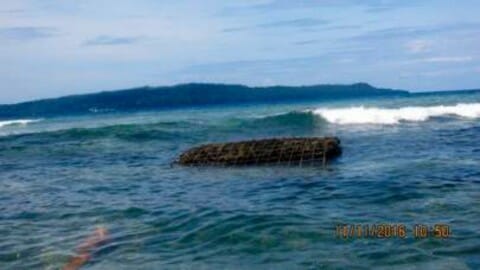
(a)
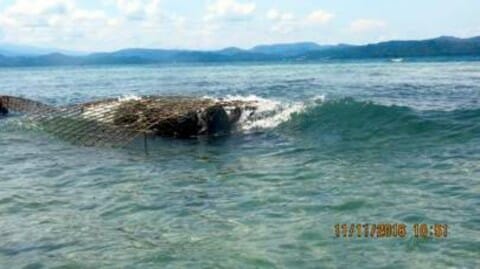
(b)
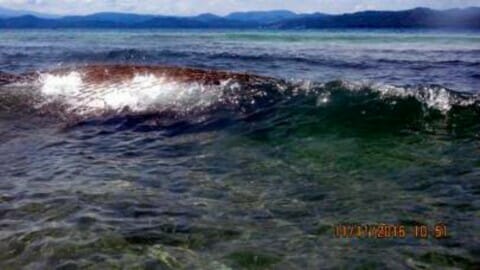
(c)
Figure 8. Diffraction of energy. Incoming wave energy dissipated by interaction with structure these photographs were taken in rapid succession, the middle picture appears brighter because of break in the clouds, and the photographer moved between the first two images. (a) approaching wave, (b) wave starting to interact with mesh, (c) wave energy dissipated by friction.
4. Discussion
We are not aware of any other case in which a badly eroded beach has been grown back so uickly and naturally. In addition, the Biorock reefs have caused prolific growth of corals, barnacles, oysters, mussels, and seagrass, and created a juvenile fish habitat [30].
Biorock reefs can be any size or shape. Mineral growth extends up to the high tide mark. They can be built entirely subtidal, as at Ihuru, entirely exposed at low tide as at Gili Trawangan, or have only the tops exposed at low tide, as at Pulau Gangga. Since the structures grow only when submerged, those in the intertidal grow most on the bottom, and least on the top. The structures attach themselves solidly to bedrock, and cement loose sand around their bases. Whether the structures are entirely submerged or partially exposed affects their wave mitigating performance. Those that are fully submerged are never visible from shore and generate real coral reef communities or oyster and mussel reefs in muddier or colder waters. Those reefs located in the intertidal zone are visible at low tide, which may be aesthetically objectionable to those who want a clear ocean view from the beach, but they are more effective in protecting the shore if there is a storm during high tide, which would pass over deeper reef structures.
The size, shape, and spacing of the modules affect their performance, and cost. What is astonishing is that record beach growth was achieved with far less material and far lower cost than sea wall or a breakwater. Conventional reinforced concrete structures are made by first building a reinforcing bar frame, and the steel is a very small part of the total cost compared to cement, stone, wooden forms, and labor. Since steel in reinforced concrete structures invariably rusts, expands, and cracks the concrete, such structures have finite lifetimes, especially in salty coastal air.
Biorock structural steel is completely protected from rusting, and the continuous growth of hard minerals makes it constantly stronger, and able to grow back first in areas that are physically damaged. The cost is far less than a reinforced concrete structure of the same size and shape, because instead of cement, rocks, labor, and wooden forms we simply provide an electrical supply instead. Estimates of Biorock reef costs range from $20-1290/m of shoreline depending on the size of the reef grown, while other methods range from $60-155,000/m, or 3-120 times more expensive [16]. The amount of electricity used is small, the entire Pulau Gangga beach restoration project uses about one air conditioner worth of electricity.
Shore protection provided by Biorock includes both production of new sand by prolific growth of calcareous algae around them, and physical protection from sand erosion by wave energy dissipation. The results of beach growth after the project was installed indicate that beach sand accumulation is a very dynamic function of wave and current interactions with reef structures. Biorock reef structures physically dissipate wave energy and reduce erosion at the shoreline, while also generating new sand. They should slow down transport of sand by north to south tidal currents at the site. That, and the interplay of the structures with waves coming from different directions, may explain why the unusual January 2017 storm seems to have transported sand in the reverse of the usual direction. Further measurements will reveal if this trend continues, or is reversed by sand production from increased calcareous algae growth around the structures.
Wave energy dissipation due to friction at the surface of the growing limestone minerals produced by the Biorock process is very quickly exceeded by the much larger, and rougher, surfaces provided by the prolific growth of corals, barnacles, sea grass, and all other living marine organisms as the structure becomes rapidly overgrown. The size, shape, and spacing of the structures, as well as the reef organisms growing on them, affect their performance as wave absorbers, and their designs can be readily changed by adding, or removing, sections as needed. Such structures can be designed to be oyster, mussel, clam, lobster, or fish habitat for highly productive and sustainable mariculture.
Biorock structures interact with waves over a very broad range of wavelengths, and are expected to produce wave diffraction on wavelength scales similar to the spacing of the structures—about 10 m—and over the spacing of the mesh—about 10 cm. Since the growing, self-repairing Biorock structures cannot be modelled by conventional hydrodynamic modeling schemes, it will be important to make physical measurements of wave energy around such structures to evaluate actual performance, and to optimize them for beach growth purposes.
The initial results of this project resulted in extraordinary beach growth, which could be improved with further experimentation under a wider range of conditions, and should be much more widely applied as a cost-effective beach restoration solution that uniquely restores marine ecosystem services.
5. Conclusions
We have grown back severely eroded beaches naturally in months by growing Biorock electric reefs in front of them. These structures cost far less than sea walls or breakwaters and work on entirely different physical principles. They restore marine ecosystems as well as beaches. The exceptionally rapid growth of corals on them [31,33] provides additional shore protection, and the rapid growth of sand-producing calcareous algae on and around them produces new biological sand supplies. These structures can easily keep pace with global sea level rise because solid hard electrochemical minerals can be grown upwards at rates up to 2 cm/year—around 5 times faster than sea level rise—and grow still much faster when corals, oysters, mussels, and other calcareous organisms cover them. As a result, Biorock shore protection reefs quickly turn eroding beaches into growing ones, can protect entire islands and even grow new ones. Biorock is the most cost-effective technology for protecting eroding coasts, for restoring fisheries habitat, and is critically needed to save the low-lying islands and coasts now threatened by global sea level rise, and the billions of coastal people who will become climate refugees if global warming is not rapidly reversed [4,12].
6. Dedication
This paper is dedicated to the memory of the late Wolf Hilbertz, who first invented the Biorockprocess of growing minerals in the ocean in 1976, and who foresaw all its applications, including shore protection.
Acknowledgments: We thank the entire management and staff of Pulau Gangga Dive Resort and its parent company, Lotus Resorts, for their willingness to try new, better, more natural and effective approaches to shore protection. Lotus Resorts paid for all materials, equipment, domestic travel, and time. The authors thank them deeply for their willingness to pioneer innovative methods of shore protection. We also thank Lori Grace for providing funds for a round trip ticket to Indonesia for Thomas J. F. Goreau to construct the device to measure beach profiles. We thank the anonymous reviewers for their constructive suggestions that have improved the original draft.
Author Contributions: T.J.F.G. and P.P. conceived, designed, built, and installed the first four Biorock Anti Wave modules and connected them to power; P.P. then built and installed the rest. T.J.F.G. analyzed the data; contributed reagents/materials/analysis tools; and wrote the paper. Although they are not listed as authors, because they did not work on the projects in the water, the entire management and staff of Lotus Resorts, operators of Pulau Gangga Dive Resort, played absolutely crucial roles in the design, logistics, funding, advice, information, and support for the work described. T.J.F.G. is a co-inventor of the Biorock electric technology of marine ecosystem restoration.
Conflicts of Interest: The authors declare no conflict of interest.
References
1. Pilkey, O.H.; Neal, W.J.; Bush, D.M. Coastal erosion; In Coastal Zones and Estuaries. Encyclopedia of Life
Support Systems (EOLSS); UNESCO: Paris, France, 1992.
2. Dieng, H.B.; Cazenave, A.; Meyssignac, B.; Ablain, M. New estimate of the current rate of sea level rise
from a sea level budget approach. Geophys. Res. Lett. 2017, doi:10.1002/2017GL073308.
3. Nieves, V.; Marcos, M.; Willis, J.K. Upper-Ocean Contribution to Short-Term Regional Coastal Sea Level Variability along the United States. J. Clim. 2017, 30, 4037-4045.
4. Goreau, T.J. Global biogeochemical restoration to stabilize CO2 at safe levels in time to avoid severe climate\change impacts to Earth’s life support systems: Implications for the United Nations Framework Convention on Climate Change. In Geotherapy: Innovative Technologies for Soil Fertility Restoration, Carbon Sequestration, and Reversing Atmospheric CO2 Increase; Goreau, T.J., Larson, R.G., Campe, J.A., Eds.; CRC Press: Boca Raton, FL, USA, 2014.
5. Levitus, S.J.; Antonov, I.; Boyer, T.P.; Baranova, O.K.; Garcia, H.E.; Locarnini, R.A.; Mishonov, A.V.; Reagan, J.R.; Seidov, D.; Yarosh, E.S.; et al. World ocean heat content and thermosteric sea leve change (0-2000 m), 1955-2010. Geophys. Res. Lett. 2012, 39, L10603, doi:10.1029/2012GL051106.
6. Gebbie, G.; Huybers, P. The Mean Age of Ocean Waters Inferred from Radiocarbon Observations: Sensitivity to Surface Sources and Accounting for Mixing Histories. J. Phys. Oceanogr. 2012, 42, 291-305.
7. Goreau, T.J. Balancing atmospheric carbon dioxide. Ambio 1990, 19, 230-236.
8. Goreau, T.J. Tropical ecophysiology, climate change, and the global carbon cycle. In Impacts of Climate Change on Ecosystems and Species: Environmental Context; Pernetta, J., Leemans, R., Elder, D., Humphrey, S., Eds.; International Union for the Conservation of Nature: Gland, Switzerland, 1995; pp. 65-79.
9. Rohling, E.J.; Grant, K.; Bolshaw, M.; Roberts, A.P.; Siddall, M.; Hemleben, C.; Kucera, M. Antarctic temperature and global sea level closely coupled over the past five glacial cycles. Nat. Geosci. 2009, doi:10.1038/NGEO557.
10. Koenigswald, W.V. Mammalian faunas from the interglacial periods in Central Europe and their stratigraphic correlation. In The Climate of Past Interglacials; Sirocko, F., Claussen, M., Sanchez Goñi, M.F., Litt, T., Eds.; Elsevier: Amsterdam, The Netherlands, 2006; pp. 445-454.
11. Koenigswald, W.V. Discontinuities in the Faunal Assemblages and Early Human Populations of Central and Western Europe During the Middle and Late Pleistocene. In Continuity and Discontinuity in the Peopling of Europe: One Hundred Fifty Years of Neanderthal Study, 101 Vertebrate Paleobiology and Paleoanthropology; Condemi, S., Weniger, G.-C., Eds.; Springer Science + Business Media B.V.: Dordrecht, The Netherlands, 2011.
12. Goreau, T.J. The other half of the global carbon dioxide problem. Nature 1987, 328, 581-582.
13. Munk, W.H.; Traylor, M.A. Refraction of Ocean Waves: A Process Linking Underwater Topography to Beach Erosion. J. Geol. 1947, 55, 1-26.
14. Wiegel, R.L. Oceanographical Engineering; Dover: New York, NY, USA, 1992.
15. Schiereck, G.J. Introduction to Bed, Bank, and Shore Protection: Engineering the Interface of Soil and Water; VSSD: Delft, The Netherlands, 2006.
16. Ferrario, F.; Beck, M.W.; Storlazzi, C.D.; Micheli, F.; Shepard, C.C.; Airoldi, L. The effectiveness of coral reefs for coastal hazard risk reduction and adaptation. Nat. Commun. 2014, doi:10.1038/ncomms4794.
17. Goreau, T.F.; Goreau, N.I.; Goreau, T.J. Corals and Coral Reefs. Sci. Am. 1979, 241, 124-136.
18. Goreau, T.J. Testimony to the National Ocean Policy Study Subcommittee of the United States Senate Committee on Commerce, Science, and Transportation, S. HRG. 101-1138: 30-37; US Government Printing Office: Washington, DC, USA, 1991
19. Hayes, R.L.; Goreau, T.J. The tropical coral reef ecosystem as a harbinger of global warming. World Resour. Rev. 1991, 3, 306-322.
20. Goreau, T.J.; Hayes, R.L.; Clark, J.W.; Basta, D.J.; Robertson, C.N. Elevated sea surface temperatures correlate with Caribbean coral reef bleaching. In A Global Warming Forum: Scientific, Economic, and Legal Overview; Geyer, R.A., Ed.; CRC Press: Boca Raton, FL, USA, 1993; pp. 225-255.
21. Goreau, T.J.; Hayes, R.L. Coral bleaching and ocean “hot spots”. Ambio 1994, 23, 176-180.
22. Goreau, T.J.; Hayes, R.L. Global coral reef bleaching and sea surface temperature trends from satellite-derived Hotspot analysis. World Resour. Rev. 2005, 17, 254-293.
23. Goreau, T.J.; Hayes, R.L.; McAllister, D. Regional patterns of sea surface temperature rise: Implications for global ocean circulation change and the future of coral reefs and fisheries. World Resour. Rev. 2005, 17, 350- 374.
24. Hilbertz, W.H.; Goreau, T.J. Method of Enhancing the Growth of Aquatic Organisms, and Structures Created Thereby. U.S. Patent No. 5,543,034, 6 August 1996.
25. Goreau, T.J.; Hilbertz, W. Marine ecosystem restoration: Costs and benefits for coral reefs. World Resour. Rev. 2005, 17, 375-409.
26. Goreau, T.J. Marine electrolysis for building materials and environmental restoration. In Electrolysis; Kleperis, J., Linkov, V., Eds.; InTech Publishing: Rijeka, Croatia, 2012; pp. 273-290.
27. Goreau, T.J. Marine ecosystem electrotherapy: Practice and theory. In Innovative Technologies for Marine Ecosystem Restoration; Goreau, T.J., Trench, R.K., Eds.; CRC Press: Boca Raton, FL, USA, 2012.
28. Wells, L.; Perez, F.; Hibbert, M.; Clervaux, L.; Johnson, J.; Goreau, T. Effect of severe hurricanes on Biorock coral reef restoration projects in Grand Turk, Turks and Caicos Islands. Rev. Biol. Trop. 2010, 58, 141-149.
29. Shyue, S.-W.; Yang, K.-C. Investigating terrain changes around artificial reefs by using a multi-beam echosounder. ICES J. Mar. Sci. 2002, 59, S338-S342, doi:10.1006/jmsc.2002.1217.
30. Goreau, T.J.; Hilbertz, W.; Azeez, A.; Hakeem, A.; Sarkisian, T.; Gutzeit, F.; Spenhoff, A. Restoring reefs to grow back beaches and protect coasts from erosion and global sea level rise. In Innovative Technologies for Marine Ecosystem Restoration; Goreau, T.J., Trench, R.K., Eds.; CRC Press: Boca Raton, FL, USA, 2012.
31. Goreau, T.J. Electrical stimulation greatly increases settlement, growth, survival, and stress resistance of marine organisms. Nat. Resour. 2014, 5, 527-537, doi:10.4236/nr.2014.510048.
32. Andrade, F.; Ferreira, M.A. A Simple Method of Measuring Beach Profiles. J. Coast. Res. 2006, 22, 995-999, doi:10.2112/04-0387.1.
33. Goreau, T.J.; Cervino, J.; Polina, R. Increased zooxanthellae numbers and mitotic index in electrically stimulated corals. Symbiosis 2004, 37, 107-120.
(CC BY) license (http://creativecommons.org/licenses/by/4.0/).
Was this a double blind experiment?
Where was the control site.
(Comments made while waiting for the download)
Hope you enjoyed the article!
We’re not sure how you can make a double blind beach restoration project unless neither the beach nor the person who restores it knows it is happening?
If we protect a beach there is no control site unless you just let it continue to erode.